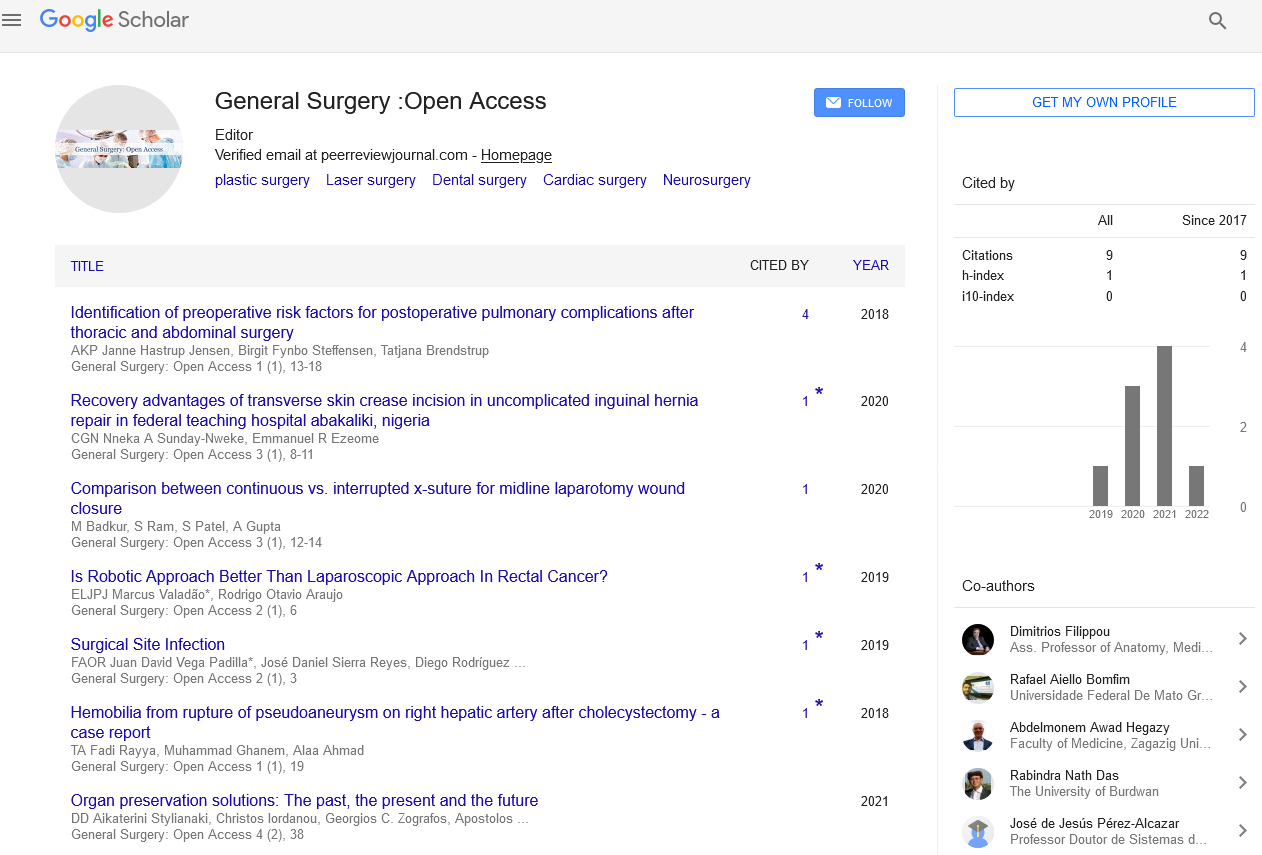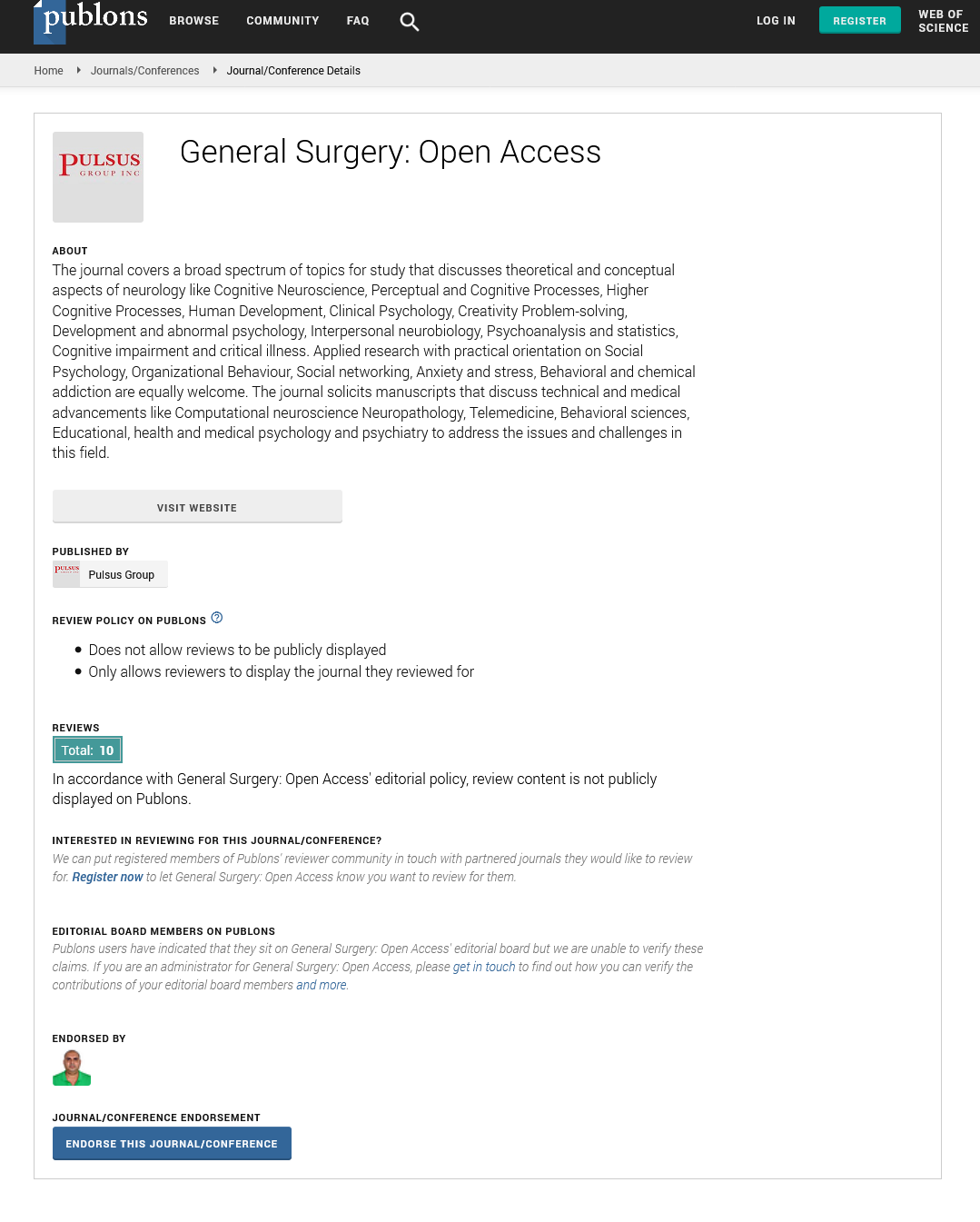Education in cardiovascular surgery and the new technologies
Received: 31-Jan-2018 Accepted Date: Feb 01, 2018; Published: 10-Feb-2018
Citation: Almeida R. Education in cardiovascular surgery and the new technologies. Gen Surg: Open Access. 2018;1(1):11-12.
This open-access article is distributed under the terms of the Creative Commons Attribution Non-Commercial License (CC BY-NC) (http://creativecommons.org/licenses/by-nc/4.0/), which permits reuse, distribution and reproduction of the article, provided that the original work is properly cited and the reuse is restricted to noncommercial purposes. For commercial reuse, contact reprints@pulsus.com
Teaching surgery, as always been a difficult challenge, for all those involved. For the last years a new field in cardiovascular surgery has arisen and, differently from the majority of new ways to treat old diseases, made a rocketing progress and established itself as a true paradigm. This is the endocardiovascular surgery. The endovascular surgery to treat cardiovascular surgery started with Thoracic Endovascular Aortic Repair (TEVAR), which quickly established itself as a safe a good procedure to treat most of the aortic diseases with good outcomes, less invasive procedure and good results at a long term follow-up [1].
This was followed by treatment of structural defects of the heart, such as septal defects, corrected by the use of structural heart occluders, and the replacement of the heart valves, namely the pulmonary, mitral and aortic (TAVI or TAVR).
With these new technologies the cardiovascular surgeon had to adapt to new methods of treatment as well as achieving as good results as the ones already used and considered the gold standard [2]. To achieve this concept of cardiovascular surgery had to be reinvented and to do so education and training in cardiovascular surgery were the starting point [3].
As part of the cardiovascular community and participating in the process of improving education, in a national and international level, trough the cardiovascular societies, have tried to contribute to the solution of this new frontier.
The changes started some years ago and were part of a team effort in training the new surgeons and retraining older and already established surgeons in these new technologies. But to start this we had to identify people capable of starting the process and more than being the facilitators of teaching these new procedures could also be mentors for all that wanted to star in these fields.
There are two paths that have to be followed and improved during this process: training the surgeons and modifying the structure of residencies. The latter one was simpler but harder to be accomplished.
Residency has been established for a long time as the way to achieve a standard of excellence for those leaving medical school. In Brazil we had a six year residence period, with two years in general surgery and four years in cardiovascular surgery. This residence was supervised by the Ministry of Education and Culture and had no link with the Brazilian Society of Cardiovascular Surgery.
After a long period of studies and discussion it was last year approved a new program of five years residence, by our society and the ministry of education, being the last year optional in a specific areas, such as pediatric cardiovascular surgery, heart transplant and heart assist devices, cardiac stimulation, minimally invasive surgery, endovascular surgery and one could always continue on general cardiovascular surgery. Apart from the initial four years of residence have periods in the cath lab, so for the new residence to acquire experience in this area.
All training is based on competence, so timing is not considered as a value in these setting. It can be argued that it is not be possible for the residents to be able to perform complicated cases, even when they have been trained simulators of virtual models [4]. This is arguable and the paradigm should be changed. As an example military aircraft pilots are trained in virtual models, for all conditions, that they are young, with no previous or minimum experience, and fly expensive planes and be capable landing on aircraft carriers
The last year in endovascular surgery is dedicated to all procedures in this area that belong to cardiovascular domain. So at the end of this year the surgeon could be able to perform as first operator any endovascular surgery such as TAVI (being femoral percutaneous approach or any other way), TEVAR, occlusion of intra or extra cardiac shunts, closure of left atrial appendage and valve repair or replacement.
All these can be achieved with an established program that apart from the theoretical program, includes time in simulators, specially designed models for hand-on and participation in endovascular surgery as first operator. The concept of performing the procedures has been extended to a collaboration between the surgeons and the invasive cardiologist, to reach a point of both specialties to work together for the benefit of the patient [5], and not only for the surgeon to be a rescuer [6].
The discussion between both Brazilian societies, the cardiovascular surgical one and the interventional cardiologic one, brought a new way for medical education in the therapeutic of heart valvular diseases. Apart from theoretical courses run by the two societies in conjunction, a resolution to certificate those capable of performing these procedures was achieved and is already being applied. The will enable to train, access improvements, qualify and certify all those who are established surgeons and desire to practice these new procedures.
To start the program a model was proposed to define the objectives and end points, develop a curriculum to produce the end points, create a program capable of offering the curriculum and evaluate and regulate all three points above [7]. To achieve different methods of teaching and learning should be accomplished as well as the evaluating method. At the end any of those completing the course are educated in this new area.
Still the most difficult point is not the changes in curriculum or the way to teach new technologies. The most difficult part is to find surgeons capable of teaching and that has a way to become mentors and not only proctors of these new technologies.
REFERENCES
- Almeida RMS, Leal JC, Saadi EK, et al. Thoracic endovascular aortic repair - A Brazilian experience in 255 patients over a period of 112 months. Interact CardioVasc Thorac Surg. 2009;8:524-28.
- Cheng D, Martin J, Shennib H, et al. Endovascular aortic repair versus open surgical repair for descending thoracic aortic disease a systematic review and meta-analysis of comparative studies. J Am Coll Cardiol. 2010;55:986-1001.
- Almeida RMS. The cardiovascular surgeon as an interventionist. Braz J Cardiovasc Surg. 2009;24:35-7
- Feins RH. Expert commentary: Cardiothoracic surgical simulation. J Thorac Cardiovasc Surg. 2008;135:485-6.
- Gomes WJ, Almeida RM, Braile DM. Multidisciplinary approach to heart disease: the patient as a priority in medical decision. Braz J Cardiovasc Surg. 2010; 25:6-7.
- Gomes WJ, Almeida RM, Braile DM. The rescue surgeon. Braz J Cardiovasc Surg. 2009;24:3-4.
- Vardas PN, Stefanescu Schmidt AC, Lou X, et al. Current Status of Endovascular Training for Cardiothoracic Surgery Residents in the United States. Ann Thorac Surg. 2017;104:1748-54.






